#hadrosauroid
Explore tagged Tumblr posts
Text

Sketch of the relic hadrosauroid Gonkoken nanoi from Maastrichtian of Chile. It is known from the numerous bones of several individuals. Gonkoken possesses a mixture of primitive and progressive traits and belongs to non-hadrosaurid hadrosauroids. It is assumed that it originated from North American forms that existed before they were replaced by hadrosaurids. The remains of Antarctic and subantarctic "hadrosaurids" may actually belong to Gonkoken-type animals. Apparently, such ornithopods flourished in the far south at the end of the age of dinosaurs. Gonkoken reached 4 meters in length and coexisted with such unusual dinosaurs as the parankylosaur Stegouros elengassen.
Adobe Photoshop, 2025.
#gonkoken nanoi#gonkoken#hadrosauroid#iguanodontia#ornithopoda#maastrichthian#latecretaceous#dinosaur#paleoart#sketch#photoshop
52 notes
·
View notes
Note
Trick or treat! :]

Equijubus!
30 notes
·
View notes
Text
Gonkoken

Gonkoken was fairly small for a hadrosauroid, at approximately 4 m in length, and exhibited a combination of basal and more derived traits. It is hypothesized that the ancestors of Gonkoken migrated south to fill herbivorous niches before being outcompeted by more advanced hadrosaurs in the northern continents.
57 notes
·
View notes
Text

I wanted to draw a dinosaur found in Italy, searching on the internet, i found a lot of information about Antonio.
The scientific name is Tethyshadros insularis, is an extinct species of dinosaur ornithopod hadrosauroid lived in the Late Cretaceous.
It was discovered by pure chance, while geologist Brazzatti was driven by the suspicion of a tectonic fault highlighted by a directional change in the calcareous layers, Brazzatti discovered the limb of a prehistoric dinosaur emerging from the ground.
This is so fascinating...
46 notes
·
View notes
Text
Qianjiangsaurus changshengi Dai et al., 2024 (new genus and species)
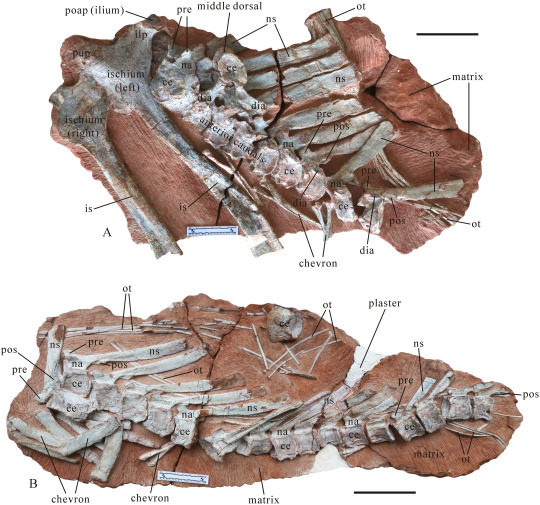
(Vertebrae and hip bones of Qianjiangsaurus changshengi [scale bar = 20 cm], from Dai et al., 2024)
Meaning of name: Qianjiangsaurus = Qianjiang lizard [in Greek]; changshengi = for Wang Changsheng [the first to formally report Cretaceous dinosaur fossils from Chongqing]
Age: Late Cretaceous (more precise age uncertain, but probably sometime within the Campanian–Maastrichtian)
Where found: Zhengyang Formation, Chongqing, China
How much is known: Partial skeleton of one individual, including parts of the skull, hips, and hindlimbs.
Notes: Qianjiangsaurus was a hadrosauroid, closely related to but not a member of the "core group" of duck-billed dinosaurs (hadrosaurids). Its overall anatomy is typical for a non-hadrosaurid hadrosauroid, but it also exhibits some features more commonly found in true hadrosaurids. It is estimated to have been about 8 m long in total body length.

(Schematic skeletal of Qianjiangsaurus changshengi [scale bar = 1 m], with preserved bones in white, from Dai et al., 2024)
Reference: Dai, H., Q. Ma, C. Xiong, Y. Lin, H. Zeng, C. Tan, J. Wang, Y. Zhang, and H. Xing. 2024. A new late-diverging non-hadrosaurid hadrosauroid (Dinosauria: Ornithopoda) from southwest China: support for interchange of dinosaur faunas across East Asia during the Late Cretaceous. Cretaceous Research advance online publication. doi: 10.1016/j.cretres.2024.105995
116 notes
·
View notes
Text

Day 2 - Gonkoken, hadrosauroid from the Late Cretaceous in the Magallanes region, Chile, described in 2023
132 notes
·
View notes
Photo

An early-diverging iguanodontian (Dinosauria: Rhabdodontomorpha) from the Late Cretaceous of North America
Lindsay E. Zanno ,Terry A. Gates, Haviv M. Avrahami, Ryan T. Tucker, Peter J. Makovicky
Abstract
Intensifying macrovertebrate reconnaissance together with refined age-dating of mid-Cretaceous assemblages in recent decades is producing a more nuanced understanding of the impact of the Cretaceous Thermal Maximum on terrestrial ecosystems.
Here we report discovery of a new early-diverging ornithopod, Iani smithi gen. et sp. nov., from the Cenomanian-age lower Mussentuchit Member, Cedar Mountain Formation of Utah, USA.
The single known specimen of this species (NCSM 29373) includes a well-preserved, disarticulated skull, partial axial column, and portions of the appendicular skeleton. Apomorphic traits are concentrated on the frontal, squamosal, braincase, and premaxilla, including the presence of three premaxillary teeth. Phylogenetic analyses using parsimony and Bayesian inference posit Iani as a North American rhabdodontomorph based on the presence of enlarged, spatulate teeth bearing up to 12 secondary ridges, maxillary teeth lacking a primary ridge, a laterally depressed maxillary process of the jugal, and a posttemporal foramen restricted to the squamosal, among other features.
Prior to this discovery, neornithischian paleobiodiversity in the Mussentuchit Member was based primarily on isolated teeth, with only the hadrosauroid Eolambia caroljonesa named from macrovertebrate remains. Documentation of a possible rhabdodontomorph in this assemblage, along with published reports of an as-of-yet undescribed thescelosaurid, and fragmentary remains of ankylosaurians and ceratopsians confirms a minimum of five, cohabiting neornithischian clades in earliest Late Cretaceous terrestrial ecosystems of North America.
Due to poor preservation and exploration of Turonian–Santonian assemblages, the timing of rhabdodontomorph extirpation in the Western Interior Basin is, as of yet, unclear. However, Iani documents survival of all three major clades of Early Cretaceous neornithischians (Thescelosauridae, Rhabdodontomorpha, and Ankylopollexia) into the dawn of the Late Cretaceous of North America.
Read the paper here:
https://journals.plos.org/plosone/article?id=10.1371/journal.pone.0286042
23 notes
·
View notes
Text

Work-in-progress sketch of a size chart of all terrestrial vertebrates from the Bajo de la Carpa formation (for a personal project of mine). The hadrosauroid and Azhdarchid are speculative editions, based on animals from nearby places at different times that may have had relatives at Bajo de la Carpa.
5 notes
·
View notes
Text

Welcome to the Juras-Sick Park-Cast podcast, the Jurassic Park podcast about Michael Crichton's 1990 novel Jurassic Park, and also not about that, too.
Find the episode webpage at: Episode 73 - The Visitor's Center.

In this episode (stream it here), my terrific guest Lindsey Kinsella returns to the show to chat with me about:
the carnotaurus, his novel The Lazarus Taxa, neat twists, his novel The Heart of Pangea, Dimetrodon narrators, naming characters, "That moment" in the book, Thylacines, Homotheriums, his new book Broken Voyage, writing from an animal's point of view, his upcoming writing projects, and much more!


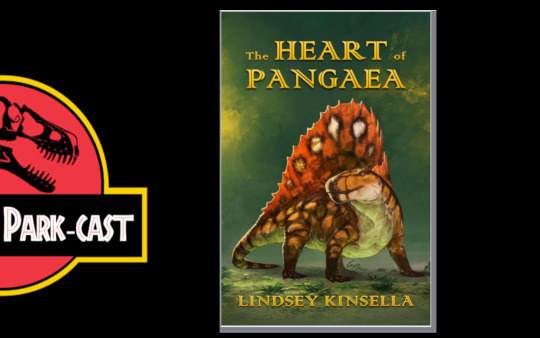
Find his new book, Broken Voyage available at this link: link!
Book review:Stranded in the Arctic, the international crew of an illegal whaler find themselves in a race for survival. Can they survive the cold, the sea, and, most of all, each other?
Pushed to desperation in a bleak world ravaged by climate change, Lora M’Bandi flees her homeland to join a group of unlikely outcasts aboard the whaling ship Livyatan. When an explosion rips through the vessel, the crew become shipwrecked deep inside the Arctic Circle—sabotaged by one of their own. Now, they must trek across the treacherous sea ice to reach dry land before the ice retreats—all the while with a traitor in their midst and fearsome predators stalking their every move.
Plus dinosaur news about:
A new late-diverging non-hadrosaurid hadrosauroid (Dinosauria: Ornithopoda) from southwest China: support for interchange of dinosaur faunas across East Asia during the Late Cretaceous. (Qianjiangsaurus changshengi)
A new titanosaur from the La Colonia Formation (Campanian-Maastrichtian), Chubut Province, Argentina. (Titanomachya gimenezi)
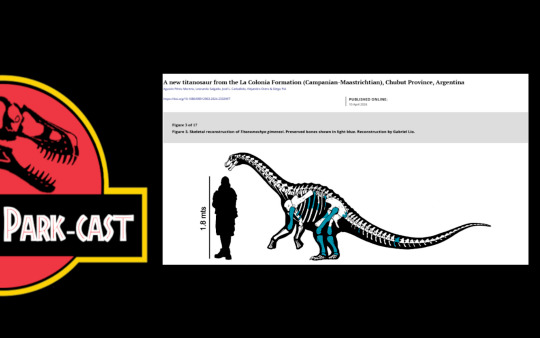
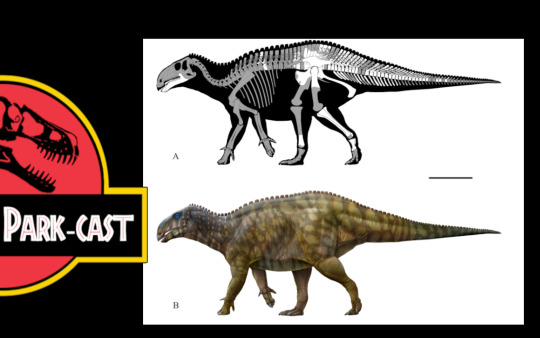
Featuring the music of Snale https://snalerock.bandcamp.com/

Intro: Chinese Cafe, and the Outro: Death of a Dream.
Then:
Jurassic Park (1993): Sc. 8 "The Visitor Center"
David Koepp's first draft, and Malia Scotch-Marmo's rewrite of Michael Crichton's draft of the script.
Corrections:
Side effects:
May cause you to become a mainstream science denier, and definitely someone who doesn't believe everything they read!
Find it on iTunes, on Spotify (click here!) or on Podbean (click here).
Thank you!
The Jura-Sick Park-cast is a part of the Spring Chickens banner of amateur intellectual properties including the Spring Chickens funny pages, Tomb of the Undead graphic novel, the Second Lapse graphic novelettes, The Infantry, and the worst of it all, the King St. Capers.
You can find links to all that baggage in the show notes, or by visiting the schickens.blogpost.com or finding us on Facebook, at Facebook.com/SpringChickenCapers or on Youtube by searching for the “Juras-Sick Park-Cast podcast” or on Tumblr @misterrogers22 or on X at @RogersRyan22 or email me at ryansrogers-at-gmail.com.
Thank you, dearly, for tuning in to the Juras-Sick Park-Cast, the Jurassic Park podcast where we talk about the novel Jurassic Park, and also not that, too. Until next time!
#JurassicPark #MichaelCrichton
#dinosaurs#jurassic park#michael crichton#dinosaur movies#youtube#podcast#dinosaur#paleontology#booktube#book tube#author#writer#carnotaurus#homotherium
1 note
·
View note
Photo

Island Weirdness #07 -- Telmatosaurus transsylvanicus
The hadrosauroid dinosaur Telmatosaurus was another resident of Hațeg Island, and while it wasn’t quite as small or specialized as its cousin Tethyshadros it was still dwarfed compared to their other relatives, only growing to about 5m long (16'4").
It was also the first dinosaur fossil found with a specific type of non-cancerous tumor known as an ameloblastoma on its lower jaw -- a surprising discovery, since ameloblastomas were previously only known to occur in mammals and a single snake species. Various other types of abnormal tissue growth have been identified in other hadrosauroids and hadrosaurs, however, suggesting that this particular lineage of dinosaurs may have been unusually susceptible to developing tumors.

#island weirdness 2019#science illustration#paleontology#paleoart#palaeoblr#telmatosaurus#hadrosauroid#hadrosauriformes#ornithopod#ornithischia#dinosaur#art#hațeg island#insular dwarfism#ameloblastoma#tumor#paleopathology#island weirdness part 1
268 notes
·
View notes
Text
Hi, this is the Holocene Dinosaur Project.
Imagine a world where 66 million years ago the Chicxulub asteroid escaped the Earth and didn't wipe out the great minds of the species, including the non-bird dinosaurs.
Imagine dinosaurs continuing their evolution.
New species and families appear, while others disappear.
What is more likely to affect their evolution are changes in climate during the Tertiary. The initially tropical hot and humid climate became cooler and drier. And the rainforests of the Palaeocene became thinner and thinner, giving way to savannahs.
On the other hand, since no asteroid impacts occurred, dinosaur evolution could have continued. Palaeontologists believe that a kind of faunal shift began in the Late Cretaceous, with large herbivores slowly disappearing and giving way to other groups.
This shift was completed by the middle of the Palaeocene. This is when the last large ceratopsids and hadrosauroids disappeared. They were replaced by the large-clawed therizinosauroids and the diverse Oviraptosaurosids.
They were hunted by the still apex predators Tyrannosauroids and Dromaeosauroids.
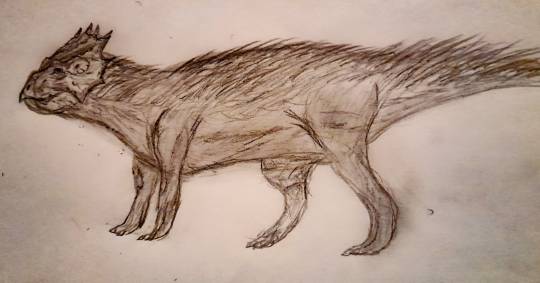
As the Palaeocene forests thinned and the understorey became richer with the influx of sunlight, the small, hitherto cavernous Leptoceratopsids and the marsh-dwelling Thescelosauroids became more abundant. Their ability to chew and the development of a multipart digestive system accelerated their spread.
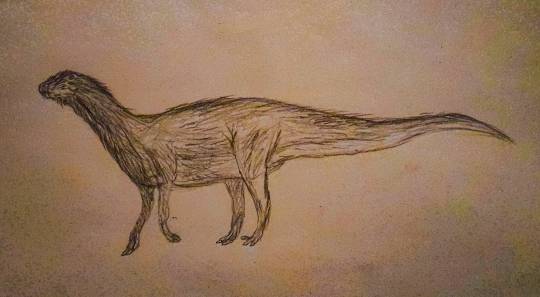
During the Eocene, the European continent, which had been an island continent, collided with Asia, and Ludoceratopsidea and other groups migrating from North America entered the new continent and displaced the extant Iguanodontidea and Titanosauroidea dinosaurs. But this mozzabat created the perfect situation for another character in the story to take the stage. Although the descendants of Balaur may look like Dromaeosauroids on the outside, this is merely the result of convergent evolution. In fact, the birds' relatives and ancestors may have arrived on the islands in flight and then become flightless due to lack of competition. Over millions of years, their descendants migrate further west and these terrormorphic predators become the food competitors of the Tyrannosauroids. They will then displace their last representatives.
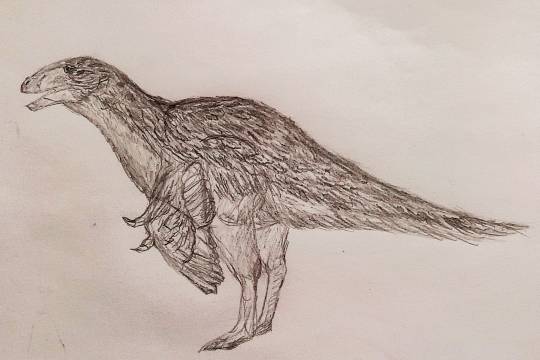
This is what the world looks like. The savannahs are roamed by four-legged, parrot-beaked herbivores, resembling feathered gazelles, and stalked by bird-like predators.
I'm going to show you the corners of this alternative land in this article, with pictures
#speculative evolution#speculative zoology#speculative biology#dinosaur#dinosaurs#art#alternative history
5 notes
·
View notes
Note
Trick or treat!

Gobihadros!
Please do not send me more trick or treat asks, I am only answering the ones I could not get to after I hit post limit last night, it is Nov 1st we have other shenanigans to attend to!
22 notes
·
View notes
Text
Koshisaurus

Koshisaurus is a basal hadrosauroid from the Early Cretaceous of what is now Japan. Its discovery suggests that hadrosauroids had higher diversity along the eastern margin of Asia in the Early Cretaceous. As a hadrosauroid, Koshisaurus was more derived than iguanodontidae, but more basal than true hadrosaurs.
50 notes
·
View notes
Note
Right you asked for this the other day so here we go, All 29 dinosaurs discovered this year
Therapoda
-Ceratosuchops, spinosaur found on the Isle of Wight -Riparovenator, same as above [Anthem's Best Name Award] -Ulughbegsaurus, Uzbekistani carcharodontosaur -Pendraig, basal therapod from Pant-y-ffynnon, Wales -Llukalkan, Argentian abelisaur -Kurupi, Brazilian abelisaur -Kansaignathus, Tajikstani dromaeosaur -Shri, Mongolian dromaeosaur -Ypupiara, unenlagiine dromaeosaur from Brazil -Tamarro, Spanish troodontid -Papilliovenator, Chinese troodontid
Ornithopoda
-Meneffeeceratops, ceratopsian found in New Mexico USA -Sierraceratops, same as above, but a chasmosaur rather than a centrosaur -Sinocephale, new name for Chinese Stegoceras species -Spicomellus, ankylosaurian from Morocco, with spikes fused onto its ribs [Anthem's Funkiest Discovery Award] -Tlatolophus, Mexican parasaurolophin hadrosaur -Ornatops, New Mexican brachylophosaurin hadrosaur -Yamatosaurus, basal Japanese hadrosaur -Portellosaurus, Spanish hadrosauroid -Fylax, Spanish hadrosauromorph -Napaisaurus, Chinese iguanodontian
Sauropoda
-Australotitan, Australian titanosaur -Hamititan, Chinese titanosaur -Ninjatitan, Argentinian titanosaur [Anthem's Worst Name Award] -Menucocelsior, another Argentianian titanosaur -Arrudititan, Brazillian titanosaur -Arackar, Chilean titanosaur -Silutitan, Chinese euhelopodid -Dzharatitanis, Uzbkistani rebbachiosaur
The fact that it's nearly the end of the year and i didn't hear about any of these before astounds me
Ty for telling me!
4 notes
·
View notes
Text
Gonkoken nanoi Alarcón-Muñoz et al., 2023 (new genus and species)

(Select bones and schematic skeletal of Gonkoken nanoi [scale bars = 50 mm for B–G, J, K–N, Q, S, and V–X, and 100 mm for H, I, O, P, R, T, and U], with preserved bones in white, from Alarcón-Muñoz et al., 2023)
Meaning of name: Gonkoken = duck/swan-like [in Tehuelche]; nanoi = for Mario “Nano” Ulloa [discoverer of dinosaur bones at the site where the original fossils were found]
Age: Late Cretaceous (Maastrichtian), between 70.5–71.7 million years ago
Where found: Dorotea Formation, Magallanes, Chile
How much is known: Numerous bones including parts of the skull, limbs, hips, and vertebral column. It is unknown whether any of these bones belonged to the same individuals, though at least three individuals are represented.
Notes: Gonkoken was a hadrosauroid, closely related to but not a member of the “core group” of duck-billed dinosaurs (hadrosaurids). All other hadrosauroids previously named from South America were true hadrosaurids. In fact, prior to the discovery of Gonkoken, non-hadrosaurid hadrosauroids near the end of the Cretaceous were not known from the Americas.
However, reexamination of supposed hadrosaurid fossils from Southern Patagonia and Antarctica suggests that these may also be remains of non-hadrosaurid hadrosauroids. It might have been that hadrosaurids (which probably originated in the Northern Hemisphere) never made it to the southern reaches of South America prior to the end-Cretaceous mass extinction, allowing other types of hadrosauroids to persist there in the absence of competition.
Reference: Alarcón-Muñoz, J., A.O. Vargas, H.P. Püschel, S. Soto-Acuña, L. Manríquez, M. Leppe, J. Kaluza, V. Milla, C.S. Gutstein, J. Palma-Liberona, W. Stinnesbeck, E. Frey, J.P. Pino, D. Bajor, E. Núñez, H. Ortiz, D. Rubilar-Rogers, and P. Cruzado-Caballero. 2023. Relict duck-billed dinosaurs survived into the last age of the dinosaurs in subantarctic Chile. Science Advances 9: eadg2456. doi: 10.1126/sciadv.adg2456
81 notes
·
View notes
Text

Last post on the series “Life Finds a Way,” this post has creatures from the letters W to Z + bonus. The rest of the series can be seen here: Part 1, 2, 3, 4, 5 and 6
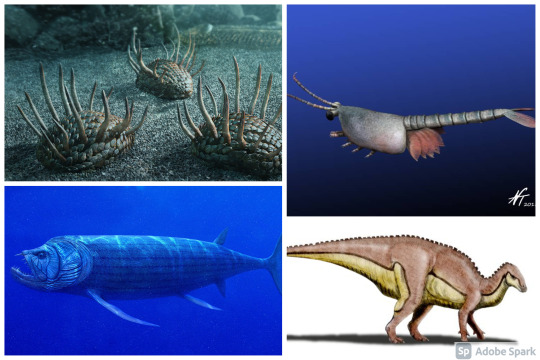
1. Wiwaxia (Top left) Genus*: Wiwaxia. Time: Cambrian- Ordovician (520-505 mya). Length: 5 centimetres (2.0 in). Weight: Since most animals from this era were soft bodied creatures with a chitinous/carbonaceous protection, all we have in fossil records are just imprints left on the rocks. It is very difficult to estimate the weight of these creatures.
2. Waptia (Top right) Genus: Waptia. Time: Middle Cambrian (509-497 mya). Length: 8 centimetres (3.1 in). Weight: Look above.
3. Xiphactinus (Bottom left) Genus: Bony predatory fish. Time: Early to late Cretaceous (112-66mya). Length: 5.1 metres (16.7 ft). Weight: Approx 1000lbs (453.5kgs)
4. Xuwulong (Bottom right) Genus: hadrosauroid dinosaur. Time: Early Cretaceous (145-100.5mya). Size: Since the creature is known from an incomplete holotype** specimen, size estimates are unavailable.

1. Yawunik (Top left): Genus: Arthropod. Time: Cambrian Period (508mya). Size: Data not available.
2. Yinlong (Top right): Genus: Balas Ceratopsian. Time: Late Jurassic (158mya). Length: 1.2 metres (3.9 ft). Weight: 15 kilograms (33 lb)
3. Zygosaurus (Bottom left): Genus: dissorophid temnospondyl. Time: Middle Permian (272.3-259 .8mya). Size: Since it is known from a holotype specimen, the size estimates are unavailable. However, the skull, which is 20cm long, indicates that this maybe one of the largest dissorophid.
4. Zuul (Bottom right): (This is the dinosaur, not the monster from Ghostbusters). Genus: ankylosaurine dinosaur. Time: Late Cretaceous (75mya) Length: 6 metres (20 ft) Weight of 2.5 tonnes (5,500 lb)
BONUS:
I realized a couple of days ago, that even though I have included the oldest known lifeform (Stromatolites) in the series, I have stayed mostly in the time period known as Phanerozoic eon, which starts from the Cambrian and extends till today, i.e. (541mya- current date). I have not given any information about a very interesting phase of life in that existed in the Proterozoic eon (2500mya-541mya). While for the most part, the planet was cooling down, there was a time near the end of the eon, known as the Ediacaran (635-541mya) , where strange, complex life forms began to appear. They are collectively known as the Ediacaran Biota. These were composed of enigmatic tubular and frond-shaped, mostly sessile***, organisms. Trace fossils of these organisms have been found worldwide, and represent the earliest known complex multicellular organisms.

* Genus: A genus (plural genera) is a taxonomic rank used in the biological classification of living and fossil organisms, as well as viruses,in biology. In the hierarchy of biological classification, genus comes above species and below family.
**Holotype: A holotype is a single physical example (or illustration) of an organism, known to have been used when the species was formally described.
***Sessile: Sessility is the biological property of an organism describing its lack of a means of self-locomotion.
Please feel free to DM me if you have any questions.
4 notes
·
View notes